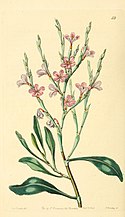Strauch-Strandflieder
| Strauch-Standflieder | ||||||||||||
|---|---|---|---|---|---|---|---|---|---|---|---|---|
 Strauch-Strandflieder (Limoniastrum monopetalum) | ||||||||||||
| Systematik | ||||||||||||
| ||||||||||||
| Wissenschaftlicher Name | ||||||||||||
| Limoniastrum monopetalum | ||||||||||||
| (L.) Boiss. |
Der Strauch-Strandflieder (Limoniastrum monopetalum) ist eine Pflanzenart aus der Gattung Limoniastrum in der Familie der Bleiwurzgewächse (Plumbaginaceae).[1]
Beschreibung
Vegetative Merkmale
Der Strauch-Strandflieder ist ein kleiner Strauch, der Wuchshöhen von 30 bis 120 Zentimetern erreicht. Er ist meist stark verzweigt.[2]
Die zahlreichen Laubblätter besitzen Salzdrüsen. Die einfache blaugrüne Blattspreite ist bei einer Länge von 2 bis 3, selten bis zu 8 Zentimetern sowie einer Breite von 0,5 bis 1,5 Zentimetern spatelförmig.[2] Der Spreitengrund geht in eine breite stängelumfassende Scheide über.[3]
Generative Merkmale
Die Blütezeit reicht von Juni bis August.[2] Ein bis zwei Blüten stehen in verzweigten, getrocknet zerbrechlichen, ährigen Blütenständen. Der Kelch ist von drei sich dachziegelig deckenden Hochblättern umschlossen. Das äußere Hochblatt ist etwa 4 Millimeter lang, das innere ist etwa 8 Millimeter lang und bildet eine ellipsoidische Hülle um die Blüten.[3]
Die zwittrige Blüten ist radiärsymmetrisch und fünfzählig mit doppelter Blütenhülle. Der 9 Millimeter lange Kelch ist fünfzähnig.[2] Die rosafarbene Blütenkrone ist am fünfzipfligen Saum 1 bis 2 Zentimeter breit; sie ist zur Hälfte verwachsen. Vertrocknet wird sie violett.[3] Die Staubblätter sind am Grunde der Blütenkrone angewachsen. Die fünf Griffel sind in der unteren Hälfte miteinander verwachsen.[3]
Die Chromosomenzahl beträgt 2n = 72.[4]
Vorkommen
Der Strauch-Strandflieder kommt in Marokko, Tunesien, im nördlichen Algerien, im nördlichen Libyen, im nördlichen Ägypten, auf der Sinai-Halbinsel, im südlichen Portugal, in Spanien, auf den Balearen, im südlichen Frankreich, auf Korsika, Sardinien, Sizilien, in Italien und auf Kreta vor.[5][1]
Der Strauch-Strandflieder gedeiht an Sandstränden und in Salzmarschen.
Taxonomie
Die Erstveröffentlichung erfolgte 1753 unter dem Namen (Basionym) Statice monopetala durch Carl von Linné in Species Plantarum, Tomus I, S. 276. Die Neukombination zu Limoniastrum monopetalum(L.) Boiss. wurde 1848 durch Pierre Edmond Boissier in Augustin-Pyrame de Candolle: Prodromus, 12, S. 689 veröffentlicht.[1][6] Synonyme für Limoniastrum monopetalum(L.) Boiss. sind: Limonium monopetalum(L.) Hill, Limoniastrum articulatumMoench, Limonium siculumMill.[5]
Nutzung
Der Strauch-Strandflieder wird gelegentlich als Zierpflanze verwendet.
Einzelnachweise
- ↑ a b c Limoniastrum monopetalum im Germplasm Resources Information Network (GRIN), USDA, ARS, National Genetic Resources Program. National Germplasm Resources Laboratory, Beltsville, Maryland. Abgerufen am 5. März 2021.
- ↑ a b c d Peter Schönfelder, Ingrid Schönfelder: Die neue Kosmos-Mittelmeerflora. Franckh-Kosmos-Verlag, Stuttgart 2008, ISBN 978-3-440-10742-3, S. 290.
- ↑ a b c d Sandro Pignatti: Limoniastrum Heister ex Fabr., S. 51 In: Thomas Gaskell Tutin, V. H. Heywood, N. A. Burges, D. M. Moore, D. H. Valentine, S. M. Walters, D. A. Webb (Hrsg.): Flora Europaea. Band 3: Diapensiaceae to Myoporaceae., Cambridge University Press, 1972, ISBN 0-521-08489-X. eingeschränkte Vorschau in der Google-Buchsuche
- ↑ Limoniastrum monopetalum bei Tropicos.org. In: IPCN Chromosome Reports. Missouri Botanical Garden, St. Louis.
- ↑ a b G. Domina (2011): Plumbaginaceae. Datenblatt Limoniastrum monopetalumIn: Euro+Med Plantbase - the information resource for Euro-Mediterranean plant diversity.
- ↑ Limoniastrum monopetalum bei Tropicos.org. Missouri Botanical Garden, St. Louis, abgerufen am 5. März 2021
Weblinks
Auf dieser Seite verwendete Medien
Autor/Urheber:
Edwards, Sydenham, 1769?-1819;
Lindley, John, 1799-1865, Lizenz: No restrictionsTitle: Edwards' botanical register, or, Ornamental flower-garden and shrubbery ..
Identifier: edwardsbotanical28edwa (find matches)
Year: 1829-1847 (1820s)
Authors: Edwards, Sydenham, 1769?-1819; Lindley, John, 1799-1865
Subjects: Plants, Ornamental -- Great Britain; Plants, Ornamental -- Great Britain; Plant introduction -- Great Britain; Alien plants -- Great Britain; Botanical illustration -- Great Britain; Botanical illustration -- Great Britain; Plants; Plants
Publisher: London : James Ridgway
Contributing Library: New York Botanical Garden, LuEsther T. Mertz Library
Digitizing Sponsor: The LuEsther T Mertz Library, the New York Botanical Garden
View Book Page: Book Viewer
About This Book: Catalog Entry
View All Images: All Images From Book
Click here to view book online to see this illustration in context in a browseable online version of this book.
Text Appearing Before Image:
'
Text Appearing After Image:
^Uii& c/M iu. (v f '!7'y^^>^/(?^ '?Ua,^AUi-.Oe/'-1 /?'/ ^%UftcUuj
Note About Images
Autor/Urheber: Xemenendura, Lizenz: CC BY-SA 4.0
Salado (Limoniastrum monopetalum), Parque Natural Bahía de Cádiz, San Fernando, (Cádiz), España
Autor/Urheber:
- Limoniastrum_monopetalum_3.JPG: Xemenendura
- derivative work: Bff
Salado (Limoniastrum monopetalum), Parque Natural Bahía de Cádiz, San Fernando, (Cádiz), España
Autor/Urheber: Franco christophe, Lizenz: CC BY-SA 3.0
Limoniastrum monopetalum






